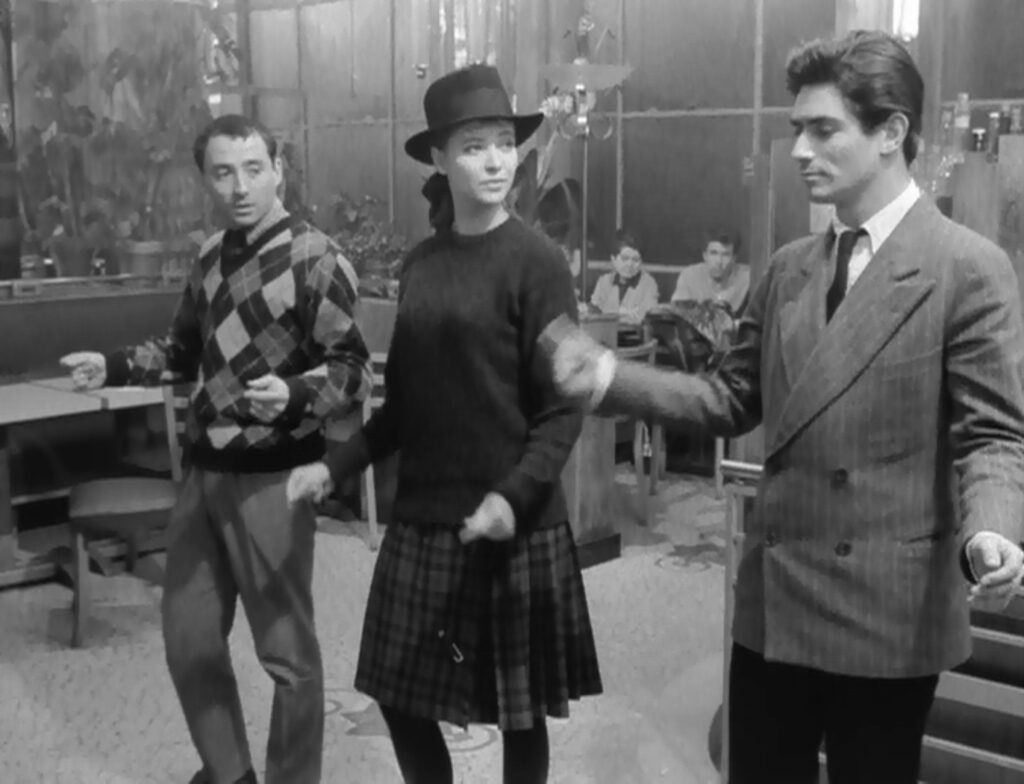
Band of Outsiders
1964, directed by Jean-Luc Godard
After the café scene in the middle of Band of Outsiders, Odile and Arthur walk past a shop called “Nouvelle Vague”, its bright neon sign conspicuous in the dark streetscape. Of course the inclusion of this sign is no accident. It’s the French name for the influential movement Godard co-founded at the end of the 1950s with a few other critics from Cahiers du cinéma as they began making films. Most viewers will get the reference, probably reading it as an inside joke that Godard couldn’t resist, like earlier allusions to New Wave films Claire’s Knee and The Soft Skin. But it’s much more than a casual allusion, and the underestimation of this neon sign is an instructive instance of a bad habit in film criticism, a tendency to acknowledge only the minimum possible intention in a movie’s signifiers. Why not at least ask ourselves whether Band of Outsiders might be about the French New Wave?
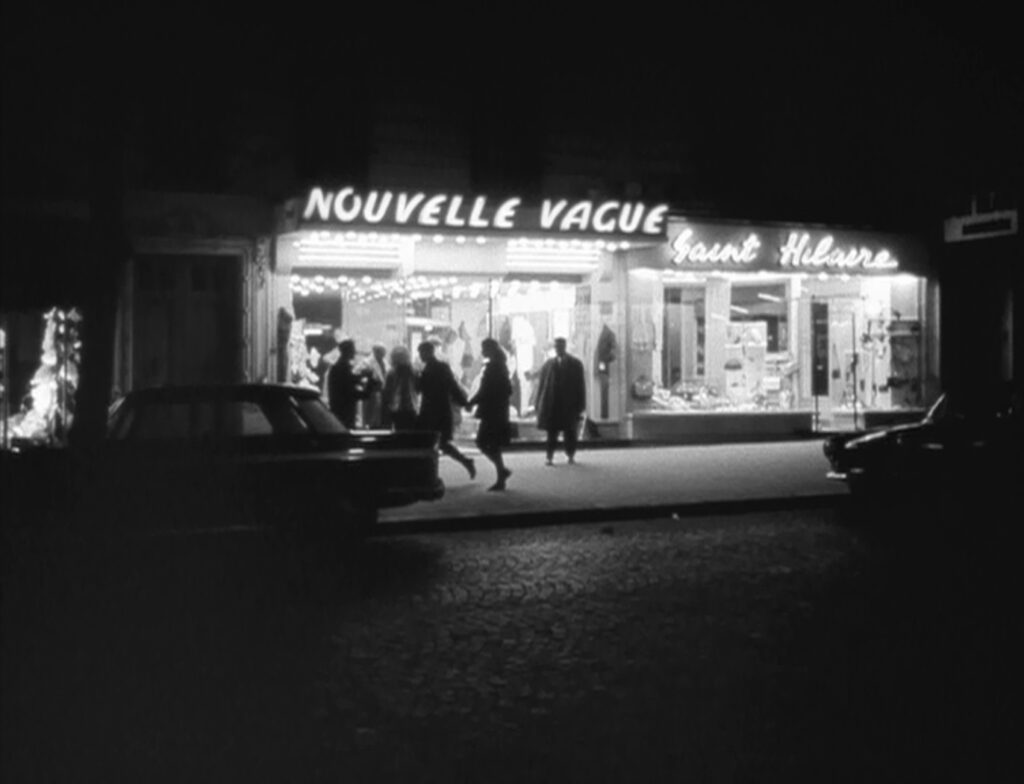
Something almost identical happens in Ozu’s Late Spring, where three different shots show an advertising mural for the American magazines Time and Life. Late Spring is about how we negotiate the difficulties of time in our lives, so that time and life are not merely themes, they’re the key elements in a thought-out argument. Similarly, Band of Outsiders is not just an offhand collection of allusions to the French New Wave, but a specific characterization of the movement’s history with its faults and potential merits.
As soon as we’re willing to entertain the idea that Band of Outsiders might be about the Nouvelle Vague itself, a few points become evident. First of all, the title is an apt description for the New Wave. Just as Arthur, Franz, and Odile are petty criminals on the fringes of society, the young critics from Cahiers du cinéma were also a band of outsiders, upending the traditional rules and order of French cinema. Second, the three protagonists attend an English class where they spend most of their time writing in notebooks (cahiers). Third, there’s a double meaning when the teacher tells the class, “The director, Monsieur Loui, is an advocate of modern methods,” and she writes “classique = moderne” on the blackboard. “Loui” is not far off from the middle name “Luc” of the movie’s own director, who was already famous for his modern cinematic methods. Unlike some of his colleagues in the Nouvelle Vague, however, Godard favored a synthetic approach, building on tradition instead of trying to overthrow it. This distinction tells us why the teacher equates the classical with the modern so emphatically.
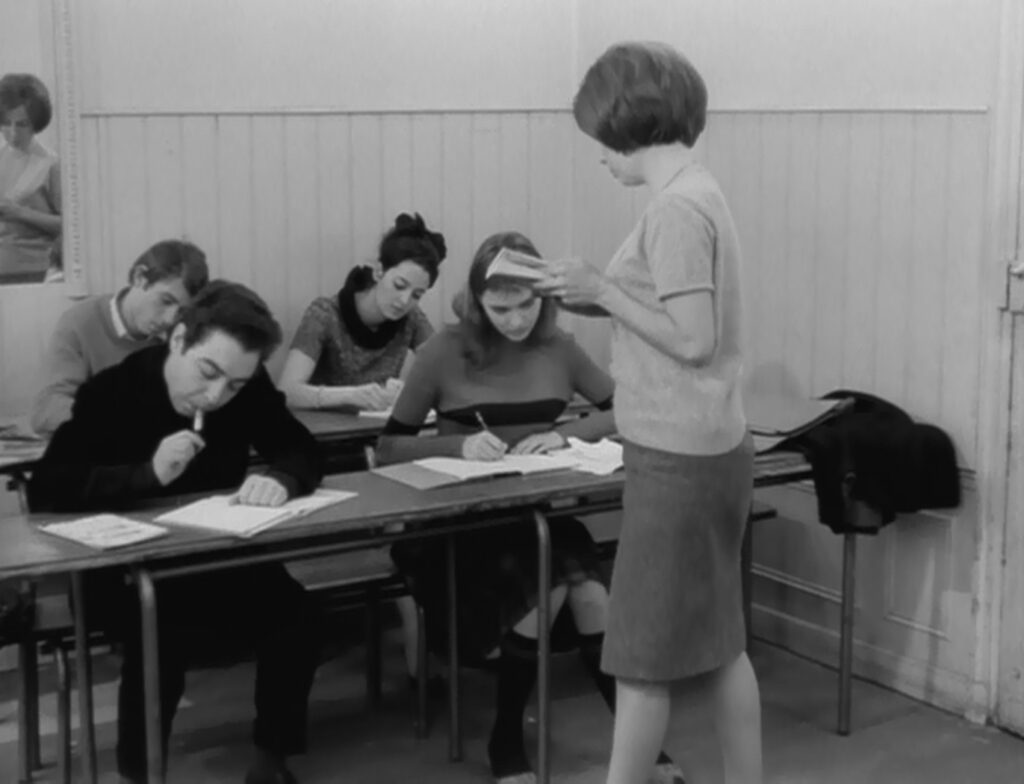
If the neon sign, the movie’s title, the notebooks, and the teacher’s statement are all more than incidental details, then it’s not likely that the location of the house where Odile is boarding, and which the three youths plan to rob, is neutral either. The house is in Joinville-le-Pont, a small suburb southeast of Paris on the Marne River. With a 1964 population below 18,000 it was a tiny part of the Paris metropolitan region, but it was famous for a big film studio that produced enough classic films to make Joinville the Hollywood of France. When Franz and Arthur plot to rob a house in Joinville, there’s therefore an insinuation that the New Wave was effectively stealing from traditional French cinema.
Godard’s most prominent colleague at Cahiers was François Truffaut, who had attracted much attention in the 1950s for his iconoclastic campaign against what he scornfully called the “cinema of quality”, by which he meant movies of high production value or high cultural pedigree that lacked the boldness and originality he expected in film. Truffaut was especially famous for his “auteur theory” which insisted that a good movie should bear the unique personal stamp of its director. Godard and Truffaut had been friends for years, even collaborating in 1958 on the short film A History of Water that was set in a flooded landscape similar to the canal-crossed terrain of Joinville. The “minute of silence” and Franz’s “Loupy the loup” line both borrow from A History of Water. By 1964 however their friendship had fallen apart, and it’s probably not a stretch to read Arthur, the least sympathetic of the trio, as a personification of Truffaut. His name, especially when pronounced in French, is close to the sound of “auteur”, and his last name Rimbaud links him to an actual writer, which is what “auteur” means. The love triangle reflects a competition between Godard (Franz) and Truffaut for the affection of the French cinema audience personified by Odile, a shy old-fashioned girl lodging with the ultra-traditional Madame Victoria, who’s tentatively willing to go along with the two youthful “outsiders” wooing her.
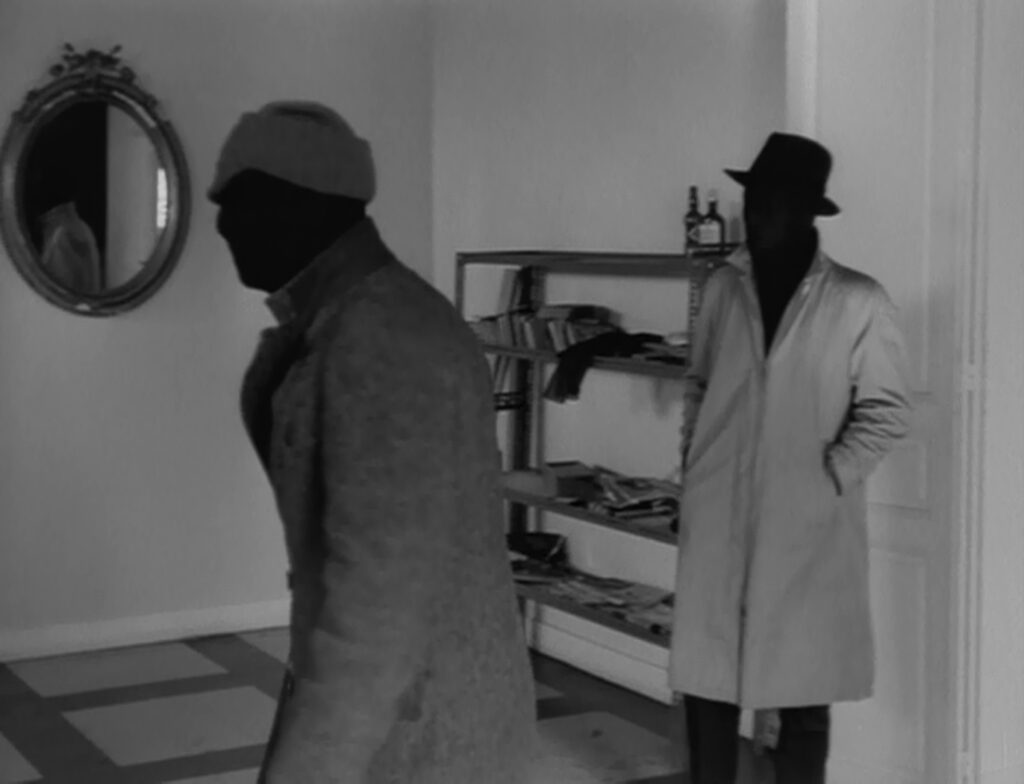
Unlike the larger-than-life criminals of so many Hollywood films, the three youths are hopeless bunglers, and they botch the robbery. Arthur and his uncle’s partner shoot each other dead, and Franz and Odile get away with a handful of banknotes, a small fraction of the whole loot, the rest of which Mr. Stolz scoops up after the shootout. Stealing from the older generation, it turns out, is not a very profitable way to make films, whether it means stealing ideas or stealing an audience. Truffaut’s films, which looked so radical to international audiences at first, look sentimental and shallow in retrospect, and his later films, following the pattern of so many revolutionaries, became as conventional as the imaginary tradition he had rebelled against. Mr. Stolz keeps most of his money, but Odile guesses that he owes it all to the government, just as French film tradition belongs to the people of France. Franz and Odile come away grateful for the little they have, as Godard recognized his debt to tradition and felt confident in charting his own course forward.
Everything in Band of Outsiders that looks so radical has antecedents in older French film, and Godard was savvy enough about cinema to be aware of this. Since the times of Méliès and Feuillade, actors had often faced their viewers, like theater actors establishing a rapport with their audience, and when Godard’s actors break character or break the “fourth wall” to look at the camera we can see an evolution of this tradition. Godard’s film is carefully structured, with long scenes at the beginning and end, each broken by a brief pause – the break in the English class, and the robbers going home to return the next day – just as the film itself is interrupted in the middle by the Madison dance; but other French directors, like Cocteau, had introduced similar symmetries. Most of all, the allegory in Band of Outsiders is like a renaissance of the allegorical tradition that flourished under the German occupation.
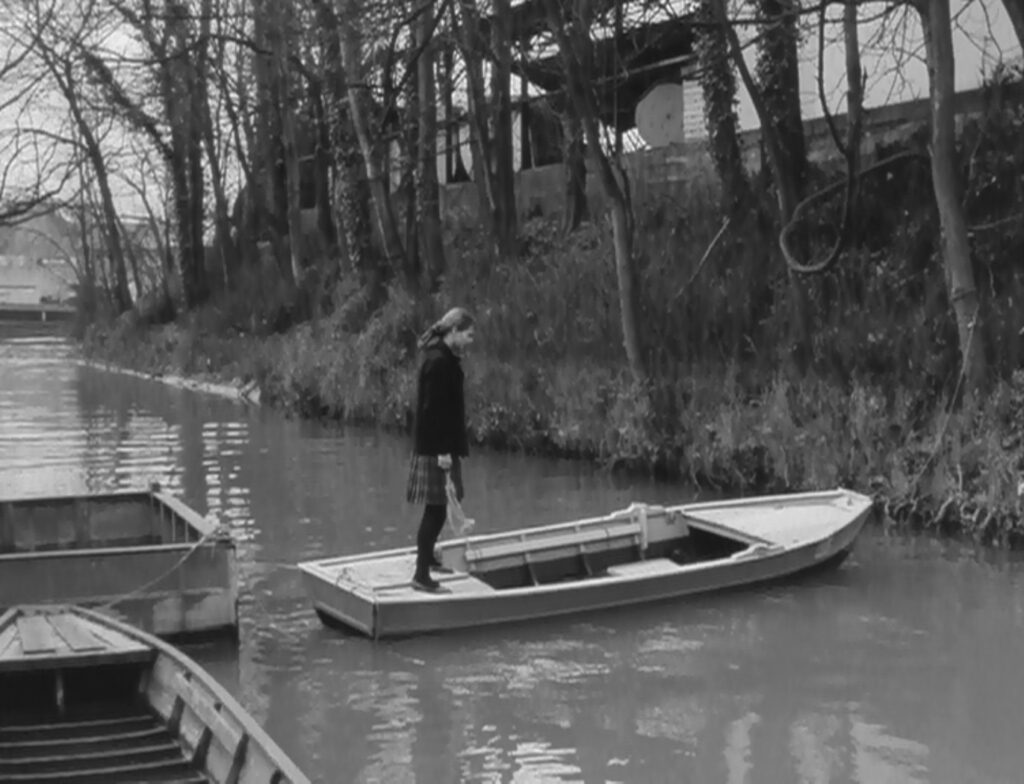
All of this might sound self-serving – after all Godard puts himself in the relatively sympathetic position of Franz, making his former friend out to be a petty thug. Nevertheless it’s done cleverly, and there’s a lot of self-criticism in admitting that he had gone along with the Nouvelle Vague’s iconoclasm for so long. The critique is also fair – Truffaut had wrecked numerous careers with his merciless criticism, and there’s a nasty oedipal flavor to his intergenerational warfare. The previous generation of French filmmakers had communicated to their audience during the Nazi Occupation with courage and imagination, and their films remain underappreciated today.
The critique of the Nouvelle Vague, however, goes beyond Godard’s antagonism toward Truffaut. There’s just as much pertinent allegory in the classroom scene as there is in the burglary. If students filling notebooks is a metaphor for the future filmmakers writing for Cahiers, it’s also significant that they’re translating Shakespeare. First of all it’s a wonderful joke that the teacher asks them to translate from French back into English, as if she expects these intermediate-level students to recompose Shakespeare’s text. But like most of Godard’s jokes, it’s more than a joke. The students, like the Cahiers critics who became filmmakers, are trying to make art – and as we should know from Vivre sa vie, Godard was dubious about the hubris of wanting to create art. When the exercise is over, one of the students reveals what’s really on his mind: “How do you say ‘A big one million dollar film?’”
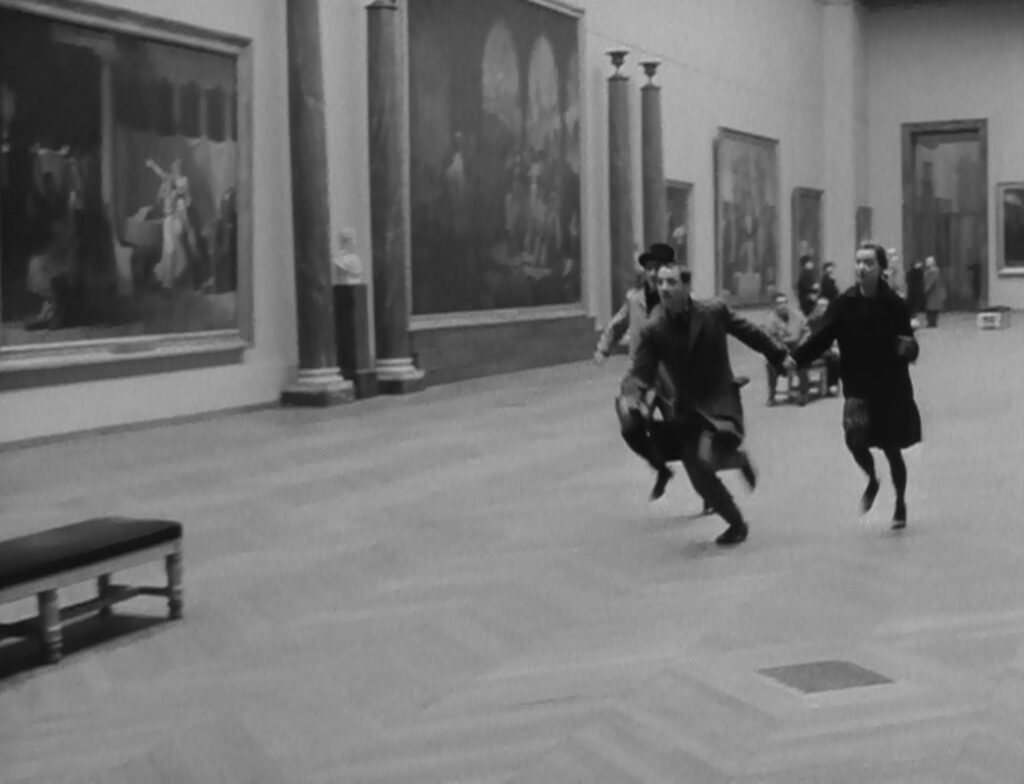
That joke aside, the critique of producing “Art” (with a capital “A” in the sense of something to be worshipped) is more than a cynical comment on underlying greed. When the teacher dictates Shakespeare for the translation exercise, it’s the death passage from Romeo and Juliet. In Vivre sa vie art is linked with death – at best it’s a dead end, an act of pride that stifles the subject that creative work should express. At worst it kills off its own subject, like the painter’s wife in Poe’s story “The Oval Portrait” which Godard’s superimposed voice reads in the final vignette. There’s an oval portrait in Band of Outsiders too, on Madame Victoria’s wall, and just before the fatal burglary begins, during the lead-up to the run through the Louvre, there’s a double allusion to Vivre sa vie:
“Arthur said they’d wait till nightfall in keeping with the tradition of bad B movies. ‘How do we kill time?’ Odile asked. Franz had read of an American who took 9 minutes 45 seconds to visit the Louvre. They decided to do better.”
First of all Vivre sa vie was dedicated to B movies – but more to the point, it ends with Nana passing the Louvre (a kind of temple of high art) right before dying. Not only does Odile speak of killing time there, but the museum again proves a harbinger of death. We don’t need to suppose that Godard was superstitious, nor to believe he was literally opposed to the paintings and sculptures in the Louvre, to understand that he saw a dangerous folly in the ambitions of would-be artists – like himself earlier, and like many of his colleagues – who were more interested in becoming recognized as grand “auteurs” than in communicating something worth expressing.
CONNECTIONS:
Late Spring – Synthetic approach to tradition; inserted sign that reveals the film’s subject
A History of Water – Watery setting, editing, playfulness, wolf line, Truffaut, moment of silence
La notte – Broken into two halves by a dance in the middle
L’eclisse – Minute of silence
Vivre sa vie – Link between art and death; oval portrait; Louvre; reference to B movies
Weekend – Characters plotting to steal from an older generation in Joinville/Oinville